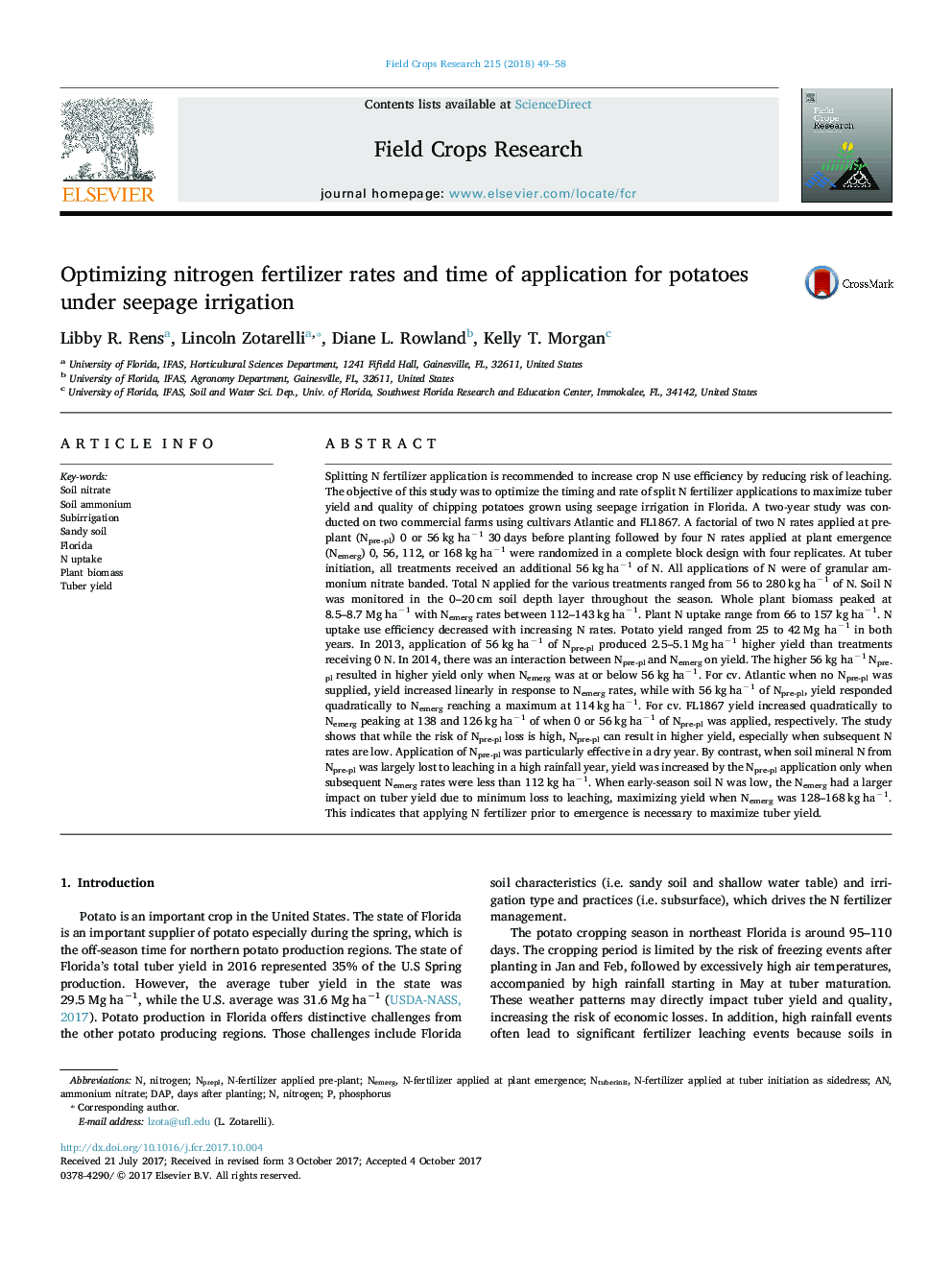| کد مقاله | کد نشریه | سال انتشار | مقاله انگلیسی | نسخه تمام متن |
|---|---|---|---|---|
| 5761455 | 1624648 | 2018 | 10 صفحه PDF | دانلود رایگان |
عنوان انگلیسی مقاله ISI
Optimizing nitrogen fertilizer rates and time of application for potatoes under seepage irrigation
ترجمه فارسی عنوان
بهینه سازی میزان کود نیتروژن و زمان استفاده از سیب زمینی تحت آبیاری آبیاری
دانلود مقاله + سفارش ترجمه
دانلود مقاله ISI انگلیسی
رایگان برای ایرانیان
کلمات کلیدی
موضوعات مرتبط
علوم زیستی و بیوفناوری
علوم کشاورزی و بیولوژیک
علوم زراعت و اصلاح نباتات
چکیده انگلیسی
Splitting N fertilizer application is recommended to increase crop N use efficiency by reducing risk of leaching. The objective of this study was to optimize the timing and rate of split N fertilizer applications to maximize tuber yield and quality of chipping potatoes grown using seepage irrigation in Florida. A two-year study was conducted on two commercial farms using cultivars Atlantic and FL1867. A factorial of two N rates applied at pre-plant (Npre-pl) 0 or 56 kg haâ1 30 days before planting followed by four N rates applied at plant emergence (Nemerg) 0, 56, 112, or 168 kg haâ1 were randomized in a complete block design with four replicates. At tuber initiation, all treatments received an additional 56 kg haâ1 of N. All applications of N were of granular ammonium nitrate banded. Total N applied for the various treatments ranged from 56 to 280 kg haâ1 of N. Soil N was monitored in the 0-20 cm soil depth layer throughout the season. Whole plant biomass peaked at 8.5-8.7 Mg haâ1 with Nemerg rates between 112-143 kg haâ1. Plant N uptake range from 66 to 157 kg haâ1. N uptake use efficiency decreased with increasing N rates. Potato yield ranged from 25 to 42 Mg haâ1 in both years. In 2013, application of 56 kg haâ1 of Npre-pl produced 2.5-5.1 Mg haâ1 higher yield than treatments receiving 0 N. In 2014, there was an interaction between Npre-pl and Nemerg on yield. The higher 56 kg haâ1âNpre-pl resulted in higher yield only when Nemerg was at or below 56 kg haâ1. For cv. Atlantic when no Npre-pl was supplied, yield increased linearly in response to Nemerg rates, while with 56 kg haâ1 of Npre-pl, yield responded quadratically to Nemerg reaching a maximum at 114 kg haâ1. For cv. FL1867 yield increased quadratically to Nemerg peaking at 138 and 126 kg haâ1 of when 0 or 56 kg haâ1 of Npre-pl was applied, respectively. The study shows that while the risk of Npre-pl loss is high, Npre-pl can result in higher yield, especially when subsequent N rates are low. Application of Npre-pl was particularly effective in a dry year. By contrast, when soil mineral N from Npre-pl was largely lost to leaching in a high rainfall year, yield was increased by the Npre-pl application only when subsequent Nemerg rates were less than 112 kg haâ1. When early-season soil N was low, the Nemerg had a larger impact on tuber yield due to minimum loss to leaching, maximizing yield when Nemerg was 128-168 kg haâ1. This indicates that applying N fertilizer prior to emergence is necessary to maximize tuber yield.
ناشر
Database: Elsevier - ScienceDirect (ساینس دایرکت)
Journal: Field Crops Research - Volume 215, January 2018, Pages 49-58
Journal: Field Crops Research - Volume 215, January 2018, Pages 49-58
نویسندگان
Libby R. Rens, Lincoln Zotarelli, Diane L. Rowland, Kelly T. Morgan,
